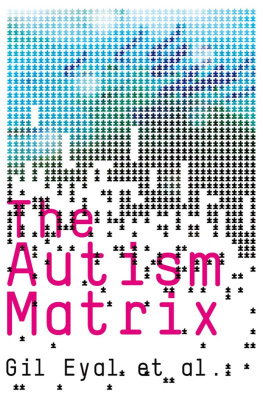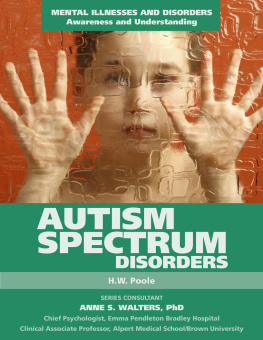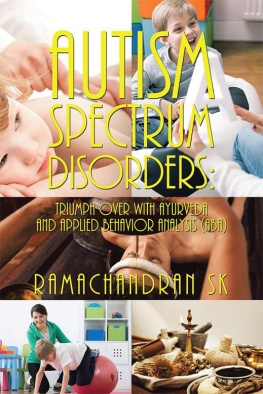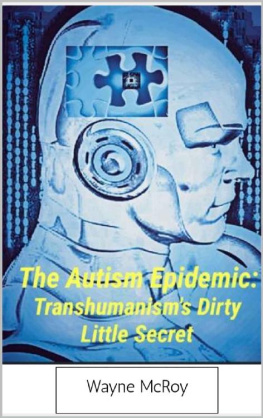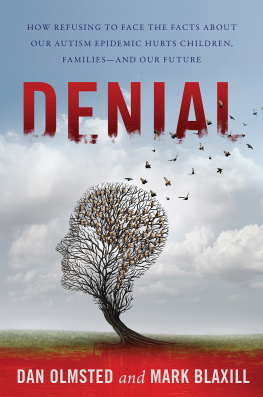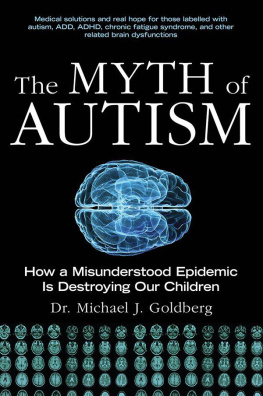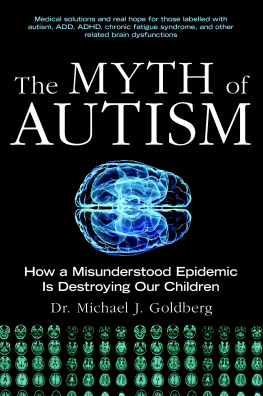THE AUTISM MATRIX
THE AUTISM MATRIX
The Social Origins of the Autism Epidemic
GIL EYAL, BRENDAN HART,
EMINE ONCULER, NETA OREN,
AND NATASHA ROSSI
polity
Copyright Gil Eyal, Brendan Hart, Emine Onculer, Neta Oren and Natasha Rossi, 2010
The right of Gil Eyal, Brendan Hart, Emine Onculer, Neta Oren and Natasha Rossi to be identied as Authors of this Work has been asserted in accordance with the UK Copyright, Designs and Patents Act 1988.
First published in 2010 by Polity Press
Polity Press 65
Bridge Street
Cambridge CB2 1UR, UK
Polity Press
350 Main Street
Malden, MA 02148, USA
All rights reserved. Except for the quotation of short passages for the purpose of criticism and review, no part of this publication may be reproduced, stored in a retrieval system, or transmitted, in any form or by any means, electronic, mechanical, photocopying, recording or otherwise, without the prior permission of the publisher.
ISBN-13: 978-07456-5640-3
A catalogue record for this book is available from the British Library.
The publisher has used its best endeavours to ensure that the URLs for external websites referred to in this book are correct and active at the time of going to press. However, the publisher has no responsibility for the websites and can make no guarantee that a site will remain live or that the content is or will remain appropriate.
Every effort has been made to trace all copyright holders, but if any have been inadvertently overlooked the publisher will be pleased to include any necessary credits in any subsequent reprint or edition.
For further information on Polity, visit our website:www.politybooks.com
CONTENTS
ACKNOWLEDGEMENTS
Many individuals provided us with useful comments after reading drafts of the manuscript or attending presentations of its main argument and ndings, others have helped us through various stages of the research that led to this book. Thanks are due to: Peter Bearman, Dalia Ben-Rabi from JDC-Brookdale Institute (Israel), Douwe Draaisma, Vivian Ducat, Dani Eshet, Dahava Eyal, Ayelet Fischer, Marion Fourcade, Gyorgy Gergely, Kim Gilbert, Robin Gurley and Marguerite Kirst Colston at The Autism Society of America, Ian Hacking, Barbara Harmon, Haim Hazan, Noa Herling and Dafna Erlich from ALUT (Israel), Dagmar Herzog, Marissa King, Eric Klinenberg, Andrew Lakoff, Tanya Luhrmann, Carol Markowitz, Xue Ming, Anne Montgomery, Dan Navon, Ari Neeman, Molly Ola Pinney, Beatrice Renault, David Schelly, Chloe Silverman, Regina Skyer, Kathy Small, Michael Staub, Rachel Tait, Zsuzsanna Vargha, Lynn Waterhouse, Juliette de Wolfe, participants in Gil Eyals Sociology of Expertise seminar at Columbia University, and the many parents who graciously took the time to share their stories and opinions with us. Thanks are also due to the editorial team at Polity Press. John Thompson shepherded the whole process with a sure hand and sage advice, and Ann Klefstad read the whole text and made useful corrections designed to make the book more communicative. Part of the research for this book was conducted with the generous support of the National Science Foundation under Grant No. 0719823. Any opinions, ndings, and conclusions or recommendations expressed in this book are those of the authors and do not necessarily reect the views of the National Science Foundation. Some of the manuscript was written while Gil Eyal was resident fellow at the Center for Advanced Studies in Stanford, California. Our thanks to the Centers director Claude Steele and deputy director Anne Petersen for their generous support.
INTRODUCTION: THE AUTISM MATRIX
Autism has become highly visible. Once you begin to look for it, you see it everywhere. Search the archived pages of major newspapers, and you will nd countless reports on scientic advances in the detection, understanding, and treatment of autism; letters to the editors protesting insurers miserly reimbursement for treatment options; dispatches from the battlefronts of special education; stories of parents love and determination in the face of tragedy, of their dogged advocacy for their children. Type the keyword autism into Yahoo! Groups and you will get 3,072 entries, from Texas-Autism-Advocacy to HBO (hyperbaric oxygen) therapy for autism. Many of these sites contain lively discussions among parents, professionals, and other interested parties who have banded together virtually for this purpose and are communicating across county and state lines, across national borders. Sort through your mail or take a walk in your neighborhood reading car stickers, and you will surely discover that April is International Autism Awareness Month, that not far from you there is a special preschool or after-hours program dedicated to autism. Stroll into your local library or bookstore and you will discover whole shelves dedicated to autism sourcebooks, advice to the parents of autistic children, memoirs of individuals with autism or of their parents. Then start talking to somebody who is also browsing through these titles.
A few clicks away, a simple question addressed to a stranger, and you will be introduced to a host of strange terms that, you recognize, you had heard mentioned before but preferred to ignore: most important, you will learn about the spectrum, about high functioning and low functioning, about Aspergers syndrome. You will hear talk about GFCF diets, chelation and mercury in vaccines. You will encounter numerous references to therapies going by various acronyms such as ABA, DIR, RDI, RPM, PRT. You will learn to refer to children as being very sensory, having OT (occupational therapy) issues, and, most alarming of all, you will begin to look at your own children, or any other children around you, differently: Do they make eye contact? How long and how well? Do they walk around on their tiptoes and like to ap their hands? Do they know how to make friends? Do they like to run their hands over the soft fabric of toys rather than play with them? Autism has not only become highly visible, its become the center of a social world, a universe of discourse complete with its own idioms, modes of seeing and judging, its own objects and devices. Wait but a little time, and you will begin to scrutinize not only childrens behavior, but your own, your parents and siblings, your childhood memories, for the telltale signs.
Why is autism so visible now? We all know the answer. There is an epidemic. In the U.S., the Center for Disease Control estimates that the prevalence of autism has increased from 4 per 10,000 in 1989 to 66 per 10,000 in 2002; that is, from 1 in 2,500 to about 1 in 150 children. We all know what an epidemic is a public health emergency. A serious and devastating illness is spreading rapidly in the population. We all know what needs to be done about epidemics. Its a call for action. Detection centers must be established so new cases are rapidly identied, isolated, and treated. Money, lots of money, must be thrown at the scientists so they will come up with an explanation and a solution. The number of new cases must be brought down, the trend reversed.
Next page
